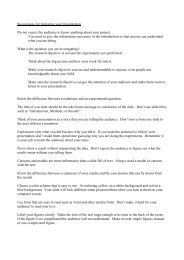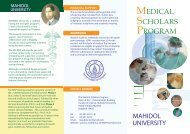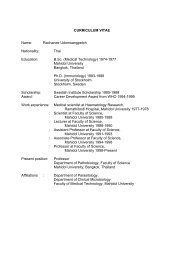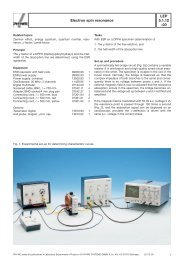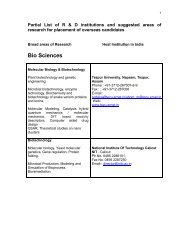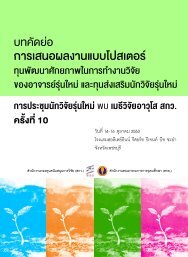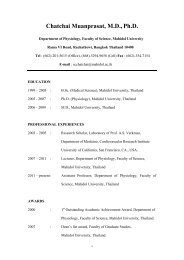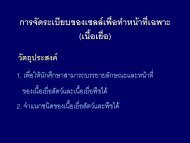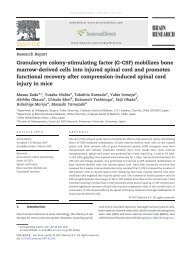Create successful ePaper yourself
Turn your PDF publications into a flip-book with our unique Google optimized e-Paper software.
NEUROPHYSIOLOGY<br />
Cerebellum: Afferent Pathways<br />
Superior cerebellar peduncle<br />
Middle cerebellar peduncle<br />
Cortical input<br />
Nucleus<br />
reticularis<br />
tegmenti<br />
pontis<br />
Pontine nuclei<br />
(contralateral)<br />
Spinal input<br />
Inferior olive<br />
Leg<br />
Arm Face<br />
To contralateral cerebellar cortex<br />
Primary fissure<br />
Upper part<br />
of medulla<br />
oblongata<br />
Spinal input<br />
Vestibular nerve<br />
and ganglion<br />
Lower part<br />
of medulla<br />
oblongata<br />
Cortical input<br />
Lateral reticular<br />
nucleus<br />
Spinal input<br />
Cervical part<br />
of spinal cord<br />
Motor interneuron<br />
Rostral<br />
spinocerebellar<br />
tract<br />
Spinal border cells<br />
Motor interneuron<br />
Lumbar part<br />
of spinal cord<br />
Clarke’s column<br />
Ventral spinocerebellar<br />
tract<br />
Vestibular<br />
nuclei<br />
To nodule and flocculus<br />
Inferior cerebellar peduncle<br />
Reticulocerebellar<br />
tract<br />
Cuneocerebellar<br />
tract<br />
Gracile nucleus<br />
Main cuneate<br />
nucleus (relay<br />
for cutaneous<br />
information)<br />
External cuneate nucleus<br />
(relay for proprioceptive<br />
information)<br />
From skin (touch<br />
and pressure)<br />
From muscle (spindles<br />
and Golgi tendon organs)<br />
From skin and<br />
deep tissues<br />
(pain and Golgi<br />
tendon organs)<br />
From skin (touch<br />
and pressure)<br />
and from muscle<br />
(spindles and<br />
Golgi tendon<br />
organs)<br />
Dorsal spinocerebellar tract<br />
Leg zone<br />
Arm zone<br />
Face zone<br />
2nd spinal<br />
projection<br />
area (gracile<br />
lobule)<br />
Archicerebellum<br />
(vestibulocerebellum)<br />
Paleocerebellum<br />
(spinocerebellum)<br />
Functional Subdivisions of Cerebellum<br />
Hemisphere Vermis<br />
Intermediate<br />
Lateral<br />
part part<br />
Lingula<br />
Flocculus<br />
Nodule<br />
Neocerebellum<br />
(pontocerebellum)<br />
Uvula<br />
Pyramid<br />
Vermis<br />
Middle vermis<br />
Hemisphere<br />
Anterior lobe<br />
Primary<br />
fissure<br />
Middle<br />
(posterior)<br />
lobe<br />
Posterolateral<br />
fissure<br />
Flocculonodular<br />
lobe<br />
Schema of<br />
theoretical<br />
“unfolding”<br />
of cerebellar<br />
surface in<br />
derivation of<br />
above diagram<br />
FIGURE 2.21<br />
CEREBELLAR AFFERENT PATHWAYS •<br />
©<br />
72<br />
The cerebellum plays an important role in coordinating movement. It<br />
receives sensory information and then influences descending motor<br />
pathways to produce fine, smooth, and coordinated motion. The<br />
cerebellum is divided into three general areas: archicerebellum (also<br />
called vestibulocerebellum) paleocerebellum (also called spinocerebellum)<br />
and the neocerebellum (also called the cerebrocerebellum).<br />
The archicerebellum is primarily involved in controlling posture and<br />
balance, as well as the movement of the head and eyes. It receives<br />
afferent signals from the vestibular apparatus and then sends efferent<br />
fibers to the appropriate descending motor pathways. The paleocerebellum<br />
primarily controls movement of the proximal portions of the<br />
limbs. It receives sensory information on limb position and muscle<br />
tone and then modifies and coordinates these movements through<br />
efferent pathways to the appropriate descending motor pathways. The<br />
neocerebellum is the largest portion of the cerebellum, and it coordinates<br />
the movement of the distal portions of the limbs. It receives<br />
input from the cerebral cortex and thus helps in the planning of<br />
motor activity (e.g., seeing a pencil and then planning and executing<br />
the movement of the arm and hand to pick it up).



